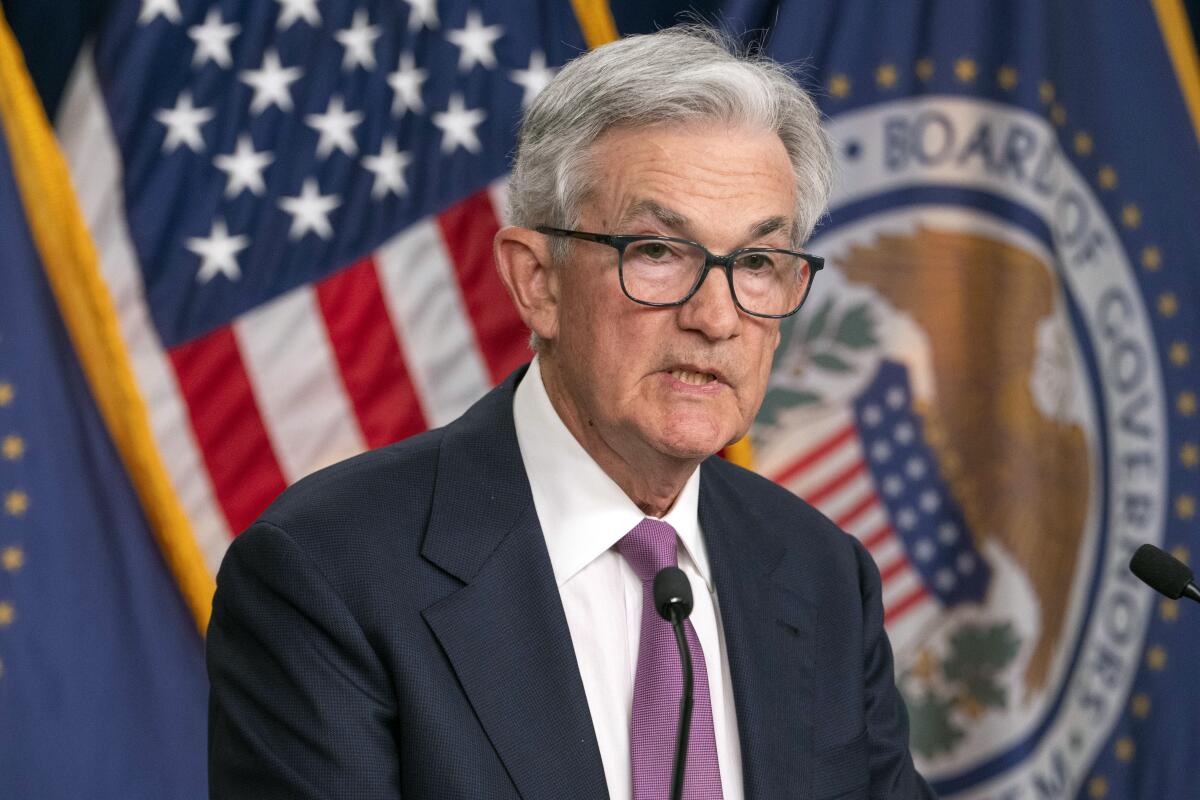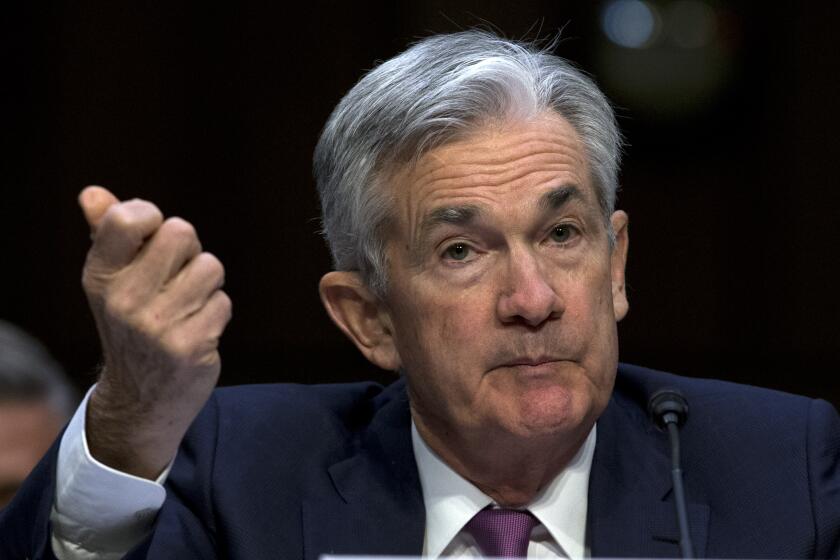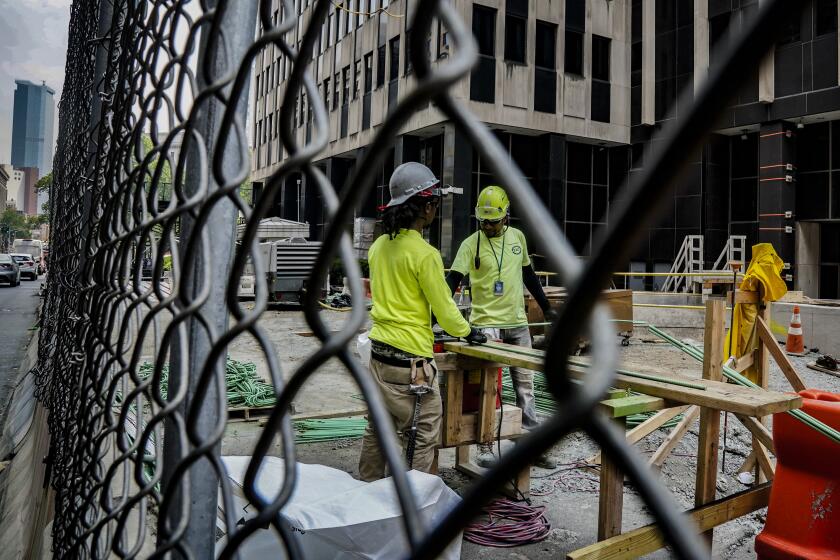Federal Reserve raises its key rate for 11th time by a quarter-point in its drive to slow inflation

- Share via
WASHINGTON — The Federal Reserve raised its key interest rate Wednesday for the 11th time in 17 months as part of its ongoing drive to curb inflation. But it provided little guidance about when — or whether — it might hike rates again.
The move lifted the Fed’s benchmark short-term rate from roughly 5.1% to 5.3% — its highest level since 2001. Coming on top of its previous rate hikes, the Fed’s latest move could lead to further increases in the costs of mortgages, auto loans, credit cards and business borrowing.
Speaking at a news conference, Fed Chair Jerome H. Powell was noncommittal about any expectations for future rate hikes. Since it began raising rates in March 2022, the Fed has often telegraphed its upcoming action. This time, though, Powell said the Fed’s policymakers may or may not raise rates again at their next meeting in September.
“It is certainly possible that we will raise rates again at the September meeting,” he said. “And I would also say it’s possible that we would choose to hold steady at that meeting.”
Powell sent a mixed message about whether he thinks the Fed will eventually need to further raise rates or instead just keep the current level of rates in place for a prolonged period.
“It was about as clear as mud, and I think that was the point,” said Diane Swonk, chief economist at accounting giant KPMG. “They don’t want to declare victory too soon. They know inflation moves in fits and starts.”
Even Federal Reserve economists know that wages had no effect on inflation. But that doesn’t stop Fed Chair Jerome H. Powell from harping on labor costs and ignoring the real culprits.
Still, Powell acknowledged that the economy has proved surprisingly resilient despite the Fed’s rapid rate hikes, with growth continuing and companies still adding jobs. He also revealed that the Fed’s staff economists no longer foresee a recession. In April, the minutes of the central bank’s March meeting had said that staff economists envisioned a “mild” recession later this year.
And he said he still thinks that a “soft landing” — in which inflation would fall back to the Fed’s 2% target, without causing a deep recession — is still possible.
“My base case is that we will be able to achieve inflation moving back down to our target without the kind of really significant downturn that results in high levels of job losses,” the Fed chair said. “We do have a shot at a soft landing.”
Though inflation has eased to its slowest pace in two years, Wednesday’s hike reflects the concern of Fed officials that the economy is still growing too fast for inflation to fall back to their 2% target. With consumer confidence reaching its highest level in two years, Americans keep spending — crowding airplanes, traveling overseas and flocking to concerts and movie theaters. Most crucially, businesses keep hiring.
Inflation has slowed sharply, so why is the Federal Reserve still intent on killing jobs and economic growth?
The key question swirling around the Fed is whether Wednesday’s increase will or won’t be its last. Though stressing that the central bank has made no decisions about any future rate increases, Powell made clear that the fight against inflation isn’t over.
“The process of getting inflation down to 2% has a long way to go,” Powell said.
He stressed that the Fed’s policymakers will assess a range of incoming economic data in determining what action, if any, to take at their next meeting. When the officials last met in June, they signaled that they expected to raise rates twice more. By the time they meet again Sept. 19-20, Powell noted, they will have much more data in hand: two more inflation reports, two reports on hiring and unemployment and updated figures on consumer spending and wages.
Some economists think the Fed might decide to forgo a rate increase in September before weighing a possible hike at its meeting in November.
In recent weeks, several Fed officials have said they worry that the still-brisk pace of job growth will lead workers to demand higher pay to make up for two years of inflationary prices. Sharp wage gains can perpetuate inflation if companies respond by raising prices for their customers.
At the same time, the steady easing of inflation pressures has lifted hopes that the Fed can bring down inflation without a recession.
America’s employers pulled back on hiring but still delivered another month of solid gains in June, adding 209,000 jobs, a sign that the economy’s resilience is confounding the Federal Reserve’s drive to slow growth and inflation.
Durable consumer spending has been a key driver of growth. Many Americans still have savings stemming from the pandemic, when the government distributed stimulus checks and people saved by spending less on travel, restaurants and entertainment.
Hiring has remained healthy, with employers having added 209,000 jobs in June and the jobless rate reaching an ultra-low 3.6%. That’s about where it was when the Fed began raising rates in March 2022 — a sign of economic resilience that almost no one had foreseen.
Year-over-year inflation in June was 3%, according to the government, down sharply from a peak of 9.1% in June 2022. One cautionary note is that a “core” measure preferred by the Fed, which excludes volatile food and energy prices, was still up 4.6% in May from a year earlier.
“Core is still quite elevated,” Powell said at his news conference.
Economists on Tuesday focused on the figure that excludes volatile autos, gas, building materials and food services, which rose a solid 0.6% in June.
Some Fed officials, including Christopher Waller, an outspoken member of its Board of Governors, and Lorie Logan, president of the Federal Reserve Bank of Dallas, have said they think the cumulative effects of the previous rate hikes have already been baked into the economy. With inflation still above the Fed’s target, they think additional hikes may be needed to further slow price pressures.
Powell echoed that point Wednesday. The Fed’s rate hikes, he said, have “not been restrictive enough for long enough” to exert their full effect.
“The process still has a long way to go,” he said.
Some analysts caution that the drop in year-over-year inflation from roughly 9% to 3% was the relatively easy part. Getting it down to the Fed’s 2% target will be harder and take longer.
Other experts say they think the recent mild inflation readings can be sustained. Rental cost increases, which have already fallen, should drop further as more apartment buildings are completed.
Though the Fed began tightening credit before central banks in many other developed countries did, most others are now following suit. The European Central Bank is expected to announce its own quarter-point rate hike on Thursday. Though inflation has declined in the 20 countries that use the euro, it remains higher there than in the United States.
The Bank of Japan is expected to keep its policies unchanged when it meets next week even though prices there are creeping higher after roughly two decades of declining. The Bank of England has been among the most aggressive in Europe, having raised its key rate last month by a half-point to a 15-year high of 5%. Year-over-year inflation in the U.K. reached a painful 8.7% in May.
More to Read
Inside the business of entertainment
The Wide Shot brings you news, analysis and insights on everything from streaming wars to production — and what it all means for the future.
You may occasionally receive promotional content from the Los Angeles Times.














